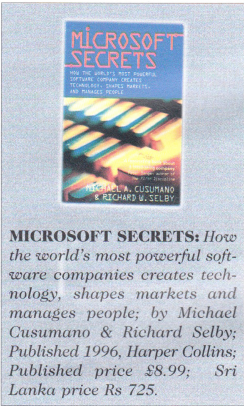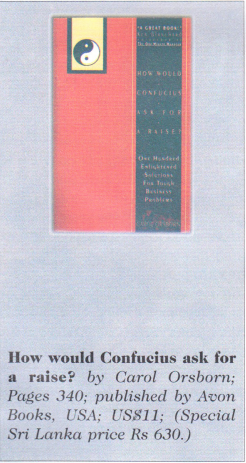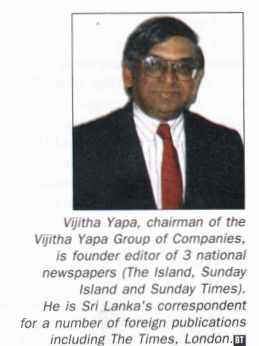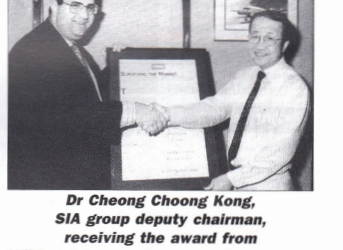
This book is an in-depth analysis of how the computer giant, Microsoft, works but the material in T it is very relevant not only for marketing strategies but also for producing products that are timely. Microsoft owns and operates systems and basic application programs on the information super highway that run the world’s 170 million computers.
The authors are both teachers. Michael Cusumano teaches strategic management of technology at Massachusetts Institute of Technology (MIT) while Richard Selby teaches information and computer science at the University of California. The study began initially as part of a MIT project to compare
the management of product development at PC software firms with those making software products for mainframes and mini computers. The authors were fascinated to discover what made Microsoft tick when many of their contemporaries who commenced business with them in the seventies had disappeared. The secret was simple- Microsoft’s effective and practical ideas in a rapidly expanding and evolving industry meant they were walking while others were still crawling or was it ‘mewling and puking in their nurse’s arms?’ Thus their products are reliable enough for companies to buy and simple for novices to understand. The second secret is that Microsoft created an approach for product development and team management (the synch and stabilize process) which allowed them to build an increasing variety of complex software products and features both for the mass market and corporate customers. No PC company has taken advantage of the demand for software. Word, Excel, Office, Windows NT, Windows 95 are only some of the products which have emerged from Microsoft.
The book provides a fascinating insight into what makes Microsoft tick. The words of one employee says it all.
Dave Maritz, who was head of the MS Dos/Windows group was a former tank commander in the Israeli Army. In order to get the individuals and teams to work towards the common goal of getting a new product out of the door, only enough direction and ironclad rules are introduced.
In the military, when I was in tank warfare and I was actually fighting in tanks, there was nothing more soothing than people constantly hearing their commander’s voice come across the airwaves. Somebody in charge, although all shit is breaking loose… When you don’t hear the commander’s voice for more than 15 minutes to half- an-hour, what’s happened? Has he been shot? Has he gone out of control? Does he know what is going on? You worry. And this is what Microsoft is. These little offices, hidden away with the doors closed. And unless you have this constant voice of authority going across the e-mail the whole time, it doesn’t work. Everything that I do here I learned in the military… You can’t do anything unless you have structure. And what you have to is to make that structure as unseen as possible and build up this image for all these prima donnas to think that they can do what they like.”
Microsoft thrives because of initiative. It went into development with smart people and smart teams, and a development process that allows large teams to work like small teams. Another important aspect is having managers who both create the product and make the technical decisions. What a contrast to companies who have no technical management who try to make technical tradeoffs.
Another very vital component of Microsoft is feedback from the users of their products and a deliberate attempt to learn from past projects.
For those who want to know what makes 42-year-old Bill Gates tick and why Microsoft is where it is today, this book is a must. It was John Seabrook who said of Bill Gates in the New Yorker, ‘IBM thought they had Gates by the balls. He’s just a hacker, they thought. A harmless nerd. What they actually had by the balls was an organism which has been bred for the accumulation of great power and maximum profit, the child of a lawyer, who knew the language of contracts and who just ripped those IBM guys apart.’ But more important, there are lessons for non-computer buffs too, as the basic principles amplified are sound management.

How relevant are the words of the Chinese sage, Confucius, to today’s competitive business world? Are there refreshing original solutions to current problems which can be found in the 3000- year-old book of wisdom? Carol Osborn will convince you there is relevance in this thoughtful book, rightly titled ‘How would Confucius ask for a raise?”
There are 100 enlightened solutions in the book, where answers can be found to such vexed questions as:
My employee acts as if I’m bugging him when I’m simply following up on the projects I’ve delegated. What’s going on here?
But in addition to these queries which thrive in any country, there are also questions which are of greater relevance to an emerging
country like Sri Lanka. Celltel’s Cellcard has made making phone calls on mobile phones more affordable. Phone prices will come down further as imported second hand (reconditioned is the more accepted word) phones find their way into Sri Lanka’s market. Thus, questions like the following will arise after the initial novelty of being given a cell phone by the company wears off.
‘Our company has supplied each of us with a private arsenal of computer notebooks and cellular car phones in order to wage hand- to-hand combat with the competition. At first we were thrilled but now we realize that we are expected either to be at work or to be available for communication 24 hours a day. Help!’
Orsborn argues that if business is like war, then communication
between campaign headquarters and the troops on the front line is of critical importance. But who says business has to be like war? Some businesses encourage the hiring and development of kami- kaze executives. The truth is that most issues faced by those of us in business on a daily basis are not worth dying for.
She raises key issues, for example, what are businesses for? Business is the vehicle through which individuals make a fair contribution of their time and energy to the community in exchange for a fair amount of money on which to live.
The one hundred examples she gives are practical and many are relevant to what Sri Lankan executives and management face daily. Take for instance this tough business problem I was the best qualified for the promotion but the offer went to somebody else. Should I fight it?’
She compares life’s challenges to a tangled ball of string. There is a place to begin, but where? The answer is to pick the issue apart strand by strand in order to gain the insight needed. The answer to the question is within you, she says, and gives an exercise which is a dialogue with one’s higher self.
At a time when the wisdom of many a sage is being reinterpreted for modern times, this book is no exception. Carol Orsborn goes straight to the point. But what is good about her book is that it is like a good math’s book there are answers at the end of each question. They do not provide the full answer one may seek but they do play a vital role in pointing to one the direction in which to seek those answers.




